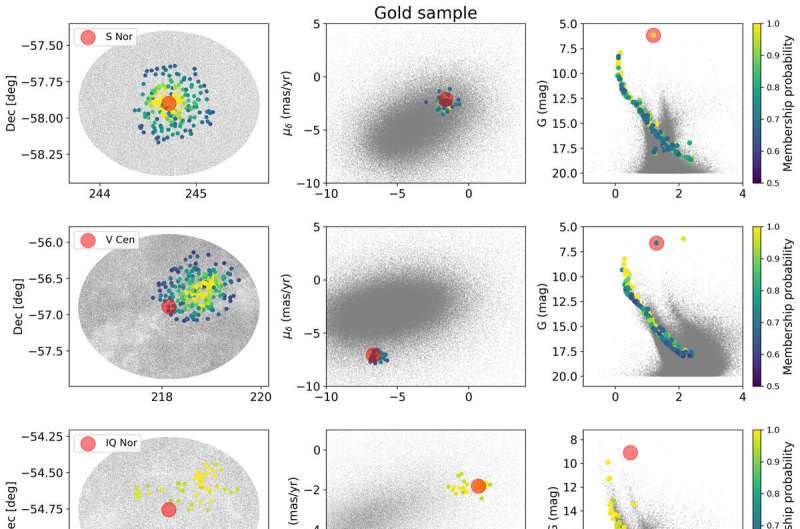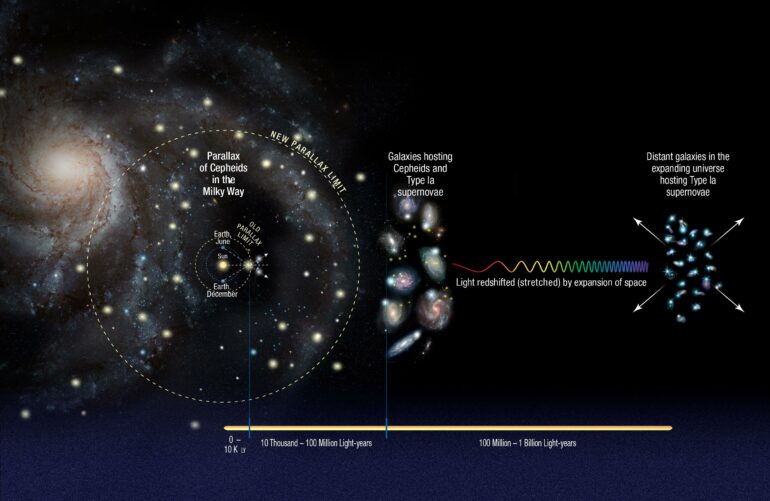The universe is expanding, but how fast exactly? The answer appears to depend on whether you estimate the cosmic expansion rate—referred to as the Hubble’s constant, or H0—based on the echo of the Big Bang (the cosmic microwave background, or CMB) or you measure H0 directly based on today’s stars and galaxies. This problem, known as the Hubble tension, has puzzled astrophysicists and cosmologists around the world.
A study carried out by the Stellar Standard Candles and Distances research group, led by Richard Anderson at EPFL’s Institute of Physics, adds a new piece to the puzzle. Their research, published in Astronomy & Astrophysics, has achieved the most accurate calibration of Cepheid stars—a type of variable star whose luminosity fluctuates over a defined period—for distance measurements to date based on data collected by the European Space Agency’s (ESA’s) Gaia mission. This new calibration further amplifies the Hubble tension.
The Hubble constant (H0) is named after the astrophysicist who—together with Georges Lemaître—discovered the phenomenon in the late 1920s. It’s measured in kilometers per second per megaparsec (km/s/Mpc), where 1 Mpc is around 3.26 million light years.
The best direct measurement of H0 uses a “cosmic distance ladder,” whose first rung is set by the absolute calibration of the brightness of Cepheids, now recalibrated by the EPFL study. In turn, Cepheids calibrate the next rung of the ladder, where supernovae—powerful explosions of stars at the end of their lives—trace the expansion of space itself.
This distance ladder, measured by the Supernovae, H0, for the Equation of State of dark energy (SH0ES) team led by Adam Riess, winner of the 2011 Nobel Prize in Physics, puts H0 at 73.0 ± 1.0 km/s/Mpc.
First radiation after the Big Bang
H0 can also be determined by interpreting the CMB—which is the ubiquitous microwave radiation left over from the Big Bang more than 13 billion years ago. However, this “early universe” measurement method has to assume the most detailed physical understanding of how the universe evolves, rendering it model dependent. The ESA’s Planck satellite has provided the most complete data on the CMB, and according to this method, H0 is 67.4 ± 0.5 km/s/Mpc.
The Hubble tension refers to this discrepancy of 5.6 km/s/Mpc, depending on whether the CMB (early universe) method or the distance ladder (late universe) method is used. The implication, provided that the measurements performed in both methods are correct, is that there is something wrong in the understanding of the basic physical laws that govern the universe. Naturally, this major issue underscores how essential it is for astrophysicists’ methods to be reliable.

Position in the sky, position in the proper motion space, and color magnitude diagram for different cluster Cepheids. Background stars are shown in gray, and the cluster membership probability is color-coded. Light colors indicate high probability. Cepheids are shown as labeled using large filled red circles. Cepheids detected as cluster members by HDBSCAN also feature an overplotted symbol to illustrate membership probability. © Astronomy & Astrophysics (2023). DOI: 10.1051/0004-6361/202244775
The new EPFL study is so important because it strengthens the first rung of the distance ladder by improving the calibration of Cepheids as distance tracers. Indeed, the new calibration allows us to measure astronomical distances to within ± 0.9%, and this lends strong support to the late universe measurement. Additionally, the results obtained at EPFL, in collaboration with the SH0ES team, helped to refine the H0 measurement, resulting in improved precision and an increased significance of the Hubble tension.
“Our study confirms the 73 km/s/Mpc expansion rate, but more importantly, it also provides the most precise, reliable calibrations of Cepheids as tools to measure distances to date,” says Anderson.
“We developed a method that searched for Cepheids belonging to star clusters made up of several hundreds of stars by testing whether stars are moving together through the Milky Way. Thanks to this trick, we could take advantage of the best knowledge of Gaia’s parallax measurements while benefiting from the gain in precision provided by the many cluster member stars. This has allowed us to push the accuracy of Gaia parallaxes to their limit and provides the firmest basis on which the distance ladder can be rested.”
Rethinking basic concepts
Why does a difference of just a few km/s/Mpc matter, given the vast scale of the universe? “This discrepancy has a huge significance,” says Anderson.
“Suppose you wanted to build a tunnel by digging into two opposite sides of a mountain. If you’ve understood the type of rock correctly and if your calculations are correct, then the two holes you’re digging will meet in the center. But if they don’t, that means you’ve made a mistake—either your calculations are wrong or you’re wrong about the type of rock.
“That’s what’s going on with the Hubble constant. The more confirmation we get that our calculations are accurate, the more we can conclude that the discrepancy means our understanding of the universe is mistaken, that the universe isn’t quite as we thought.”
The discrepancy has many other implications. It calls into question the very fundamentals, like the exact nature of dark energy, the time-space continuum, and gravity. “It means we have to rethink the basic concepts that form the foundation of our overall understanding of physics,” says Anderson.
His research group’s study makes an important contribution in other areas, too. “Because our measurements are so precise, they give us insight into the geometry of the Milky Way,” says Mauricio Cruz Reyes, a Ph.D. student in Anderson’s research group and lead author of the study. “The highly accurate calibration we developed will let us better determine the Milky Way’s size and shape as a flat-disk galaxy and its distance from other galaxies, for example. Our work also confirmed the reliability of the Gaia data by comparing them with those taken from other telescopes.”
More information:
Mauricio Cruz Reyes et al, A 0.9% calibration of the Galactic Cepheid luminosity scale based on Gaia DR3 data of open clusters and Cepheids, Astronomy & Astrophysics (2023). DOI: 10.1051/0004-6361/202244775
Provided by
Ecole Polytechnique Federale de Lausanne
Citation:
A new measurement could change our understanding of the universe (2023, April 4)


